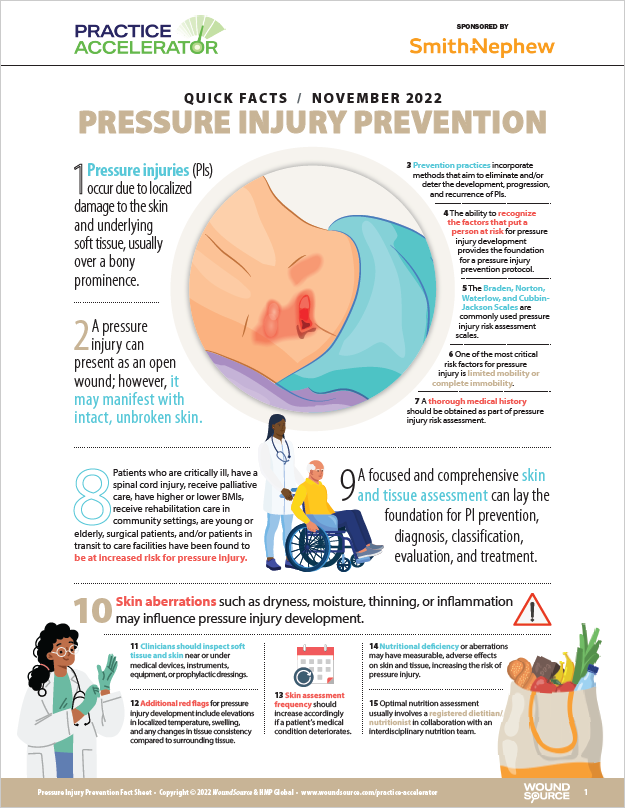
Pressure Injury Prevention
For this month's WoundSource Practice Accelerator series, we are providing education on a variety of topics related to the prevention and management of pressure injuries. Scroll below to read this month's white paper and articles, to print out our quick fact sheet, and to sign up for this month's webinar.
Upcoming Webinar
Preventing Pressure Injuries in Patients with Limited Mobility
Angelia Rose, APRN, MSN, FNP-C, CWCN-APThis webinar will review risk factors for pressure injury development and interventions to offset those risk factors. The speaker will examine best practices and the use of technologies like foam dressings and wearable patient monitoring technologies, as well as alternative techniques.
White Paper
Elements of a Pressure Injury Prevention Plan
Pressure injuries (PIs) result from pressure- or shear-induced localized damage to the skin and underlying soft tissue, usually over a bony prominence. Prevention practices take into account underlying risk factors and aim to eliminate and/or deter the development, progression, and recurrence of PIs. This Practice Accelerator white paper emphasizes the importance of a thorough skin assessment, as well as a complete medical history and nutrition profile, to guide initiatives to reduce PI risk and...Fact Sheet
Quick Facts: Pressure Injury Prevention 2022
Pressure injuries (PIs) represent localized damage to the skin and underlying soft tissue, usually over a bony prominence. These injuries are often open wounds, but they may also manifest with intact, unbroken skin. PI prevention begins with assessment, including a medical history, a head-to-toe physical examination, and the use of validated scales to determine PI risk. Preventive measures include repositioning, use of support surfaces and offloading, and management of underlying comorbidities a...Featured Articles
Preventing Medical Device-Related Pressure Injuries
Medical device-related pressure injuries (MDRPIs) are defined as injuries associated with using devices applied for diagnostic or therapeutic purposes, where the injury tends to have the same configuration as the device. Individuals using medical devices are more than twice as likely to develop pres...
Read MorePressure Injury Risk Assessment
A pressure injury (PI) is defined as a localized injury to the skin and/or underlying tissues caused by pressure either alone or in combination with shear. Hospitalized patients worldwide frequently present with PIs, and these injuries can lead to prolonged hospital stays, increased medical expenses...
Read MoreTurning and Positioning for Pressure Injury Prevention
Pressure injuries are injuries to the skin and deeper tissues that occur due to direct pressure, shear, or friction forces. It is estimated that in the United States, 2.5 million pressure injuries occur yearly in acute care facilities alone. The price of managing a single full-thickness pressure inj...
Read MorePressure Injury Prevention: What Areas Are at Risk?
According to the National Pressure Injury Advisory Panel (NPIAP) definition, “A pressure injury is localized injury to the skin and/or underlying tissue usually over a bony prominence, as a result of pressure, or pressure in combination with shear and/or friction.” Pressure injuries are an unfortuna...
Read More










